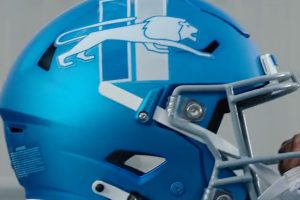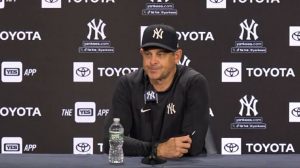
Detroit Lions head coach Dan Campbell addresses the media after an NFL football game against the Baltimore Ravens, Sunday, Oct. 22, 2023, in Baltimore. (AP Photo/Nick Wass)
ESPN Report: NFL Has Been Banned Lions Head Coach Dan Campbell For One Years For Insulting “Sheila Ford Hamp”….
Win, lose or draw, one thing’s for sure: When it comes to Detroit Lions head coach Dan Campbell, All-Pro offensive lineman Penei Sewell says he’s “got his back until the end.”
Campbell has received criticism for twice deciding to go for it on fourth down instead of kicking a field goal in the second half of Sunday’s NFC Championship Game loss to the San Francisco 49ers.
Sewell, however, refuses to blame the loss on Campbell.
“I don’t agree with any criticism towards Coach. I’ve got his back until the end,” Sewell told ESPN from Orlando, Florida, during an Accelerator Active Energy event with popular YouTuber Donald De La Haye Jr., aka “Deestroying.”
“If he tells me to jump off a cliff with him, I’m right next to him,” Sewell said of Campbell. “I’m so serious. So, whatever he says, whatever he calls, we’ve just got to execute. So, that’s on us really. That’s my guy.”
Detroit ended just one win shy of reaching its first Super Bowl, with the Lions winning two playoff games in the same postseason for the first time since 1957 and matching the franchise record for most wins in a single season (12).
In his third season, Sewell was voted one of six team captains and allowed just one sack on 1,178 offensive snaps played. He is considered a foundational player for the organization and made the Pro Bowl for the second straight year. He credited maturity for his improvement.
“I’m just more comfortable with everything and I’ve experienced more at the end of the day,” Sewell said. “And the game is slower and that’s pretty much it.”
With defensive coordinator Aaron Glenn and offensive coordinator Ben Johnson both returning to Detroit next season after receiving head-coaching interest, Sewell says he wasn’t surprised with their decisions. The goal is to build something special.
“It’s family really. Those two guys coming back, it kind of solidifies that and it just speaks to it,” Sewell said. “It’s on for real. We all love them.”
The expectations are high in Detroit entering next season. And Sewell says the Lions have unfinished business.
“Every new year going in, there’s always another level to tap into, and I feel like there’s no limit and we’ve just got to go attack it like that,” he said.
READ MORE.
49ers-Chiefs Super Bowl overtime decision: Did Kyle Shanahan blow it?
I thought I was done with Super Bowl LVIII, but one conversation that keeps happening has pulled me back in. I touched on San Francisco coach Kyle Shanahan’s decision to take the ball first in overtime in my recap column last Monday, but after stories broke that some 49ers players didn’t know the rules and video was released of the Chiefs celebrating Shanahan’s decision on the sideline, it has turned into a much bigger story.
When I wrote about the game — which ended with the Chiefs scoring a touchdown on the second possession of overtime — I suspected the conversation Monday morning would work on finding a scapegoat for what had gone wrong. Given Shanahan’s issues in losing two prior Super Bowls, he was the most likely target, with many conflating several 49ers players not knowing the new overtime rules to Shanahan himself not understanding the options available.
You could argue his scapegoat instead became defensive coordinator Steve Wilks, who came within a fourth-down stop of winning a Super Bowl before being fired last week. I’d point toward the 49ers’ pass-blockers, who made multiple mental mistakes and likely cost Brock Purdy & Co. multiple touchdowns in the process. More realistically, San Francisco lost for several reasons, none of which should be the single sole factor to blame.
Subscribe: “The Bill Barnwell Show”
Having had a week to digest arguments, it seems like a good time to take a longer look both at Shanahan’s specific decision and what your favorite team’s coach should choose if he’s lucky enough to make it to overtime in the postseason next season. Is it as simple as following what the Chiefs did? I’m not so sure. Let’s run through the arguments I’ve seen in favor of choosing to get the ball first or second and evaluate whether they hold up:
“We already know what to do from college football. Go second so you can know what you need. Problem solved.”
This is the argument I saw most often about this decision, and it’s just wrong. While there’s certainly a benefit to getting the ball second — let’s call this being Team 2 from this point forward — and knowing what you need, there are two major differences between the NFL’s playoff overtime process and college football’s. One is field position: The NFL’s rule starts each possession with a standard kickoff, while college football overtime begins on the 25-yard line for two possessions before starting on the 3-yard line for the third overtime.
The other difference is more significant, and it’s the factor Shanahan brought up in making his decision. In college football, teams always get a chance to either match or top the first team’s (Team 1) score on their drive, so there’s not much thought: Most teams will prefer to be Team 2 and know what they need if they want to win. With that being said, from 2013 to 2021, Team 2 won only 51% of the time in a 243-game sample of college football overtimes, so this isn’t a significant advantage.
If the two NFL teams are tied after they each get one possession with the football, though, Team 1 gets the ball for the third possession of overtime with the opportunity to win by scoring a field goal or touchdown — without giving the ball back to the opposing team. That’s a dramatic advantage! Remember that from 1994 to 2011, when NFL teams were able to win in overtime by kicking a field goal and without needing to give the opposition another possession, teams that won the coin toss won the game nearly 60% of the time. If Team 1 gets to the third possession of overtime, it’s essentially playing a game as if it had won the toss under the league’s old playoff rules.
That 60% number also underestimates Team 1’s chances of winning on drive No. 3 of overtime. The NFL was spurred to make the change in part by the improving performance of kickers on long-distance field goals, which has only continued. From 2000 to 2011, kickers hit just over 55% of their field goals in the 50- to 59-yard range. Over the past five seasons, that mark is up to 66.6%. The league has moved up the field position for touchbacks from the 20-yard line to the 25, adding 5 free yards for offenses. With defenses tired after a full game and another possession of overtime, it also should be easier to move the ball. Teams might need only 35 yards on that third drive to get into field goal range for a good kicker.
Make no mistake: Getting the ball third is an enormous advantage if a team can get there. The “if” is the hard part.
Argument No. 2: You’re not getting the ball back!
“There’s no chance of getting the ball for a third possession, because whichever team goes second will just go for two or make whatever decision it needs to make to avoid letting the opposing team get the ball back.”
Knowing what you need is the benefit of getting the ball second. For Team 1, getting the ball third is going to be a bigger advantage than knowing what it needs and taking it second, but the trade-off is it might never get to realize that opportunity. Going second means Team 2 always get the second-mover advantage on that second possession and it can make its decisions accordingly. That’s the trade-off being made by choosing first or second. Would you rather have a smaller advantage you’re guaranteed to see or a significant advantage you might never get to enjoy?
The answer depends on how confident you are about getting to that third drive, which many have correctly pointed out will be influenced by that second-mover advantage. If Team 2 knows Team 1 will have a huge advantage on that third possession, Team 2 should be aggressive in trying to top Team 1 and win on the second possession of the game. We didn’t see the Chiefs forced to any sort of meaningful decision in the Super Bowl, though they needed to go for it on fourth-and-1 inside their own territory to extend the game.
Will Team 2 actually be that aggressive in reality? It’s hard to say. This is uncharted territory — Super Bowl LVIII was the first overtime playoff game played under this format — and it’s hardly as if coaches are as aggressive as the evidence suggests they should be during regulation, which is a game state everyone’s already familiar with and should understand. It’s easier to think about why this might be an issue if we split it out by what happened on Team 1’s opening possession of overtime:
Team 1 doesn’t score on the opening drive. Great! Now, Team 2 has that ideal advantage we talked about on the third possession, but it has it on the second possession instead; it can win with a field goal and doesn’t have to give the opposing team a chance to match. That’s a great situation to be in, and it both makes getting the ball second a more valuable proposition and should encourage Team 1 to be more aggressive than normal on their first possession to avoid giving Team 2 that advantage.
At the same time, there will be plenty of scenarios where Team 2 gets the ball and also doesn’t score, like a game between two excellent defenses or in terrible weather conditions. Maybe both teams take a sack on their opening drives and end up in fourth-and-long and can’t even consider going for it. Team 2 could end up failing on a fourth-and-short outside of field goal range, as the Chiefs could have against the 49ers. They could miss a field goal.
They could also have a conservative coach who makes suboptimal decisions on fourth downs in general and leans on “trusting his defense” and punts as opposed to trying a long field goal and running the risk of handing the opposing team a short field. We’ve seen coaches make inexplicable decisions during the regular season; in 2022, Broncos coach Nathaniel Hackett let the clock run down and tried a 64-yard field goal down one point in Seattle because he thought Brandon McManus’ chances of converting were better than that of picking up a fourth-and-5. Don’t assume Team 2’s coach will run things like he’s John Harbaugh or Dan Campbell.
Team 1 kicks a field goal on its opening drive. Here’s the scenario that played out Sunday. The 49ers got inside the red zone but stalled out when right guard Spencer Burford whiffed in pass protection, giving Chris Jones a free rush at Purdy and forcing a throwaway. (In my recap of the game written before the All-22 footage was available, I blamed right tackle Colton McKivitz for the pass protection gaffe; after getting to see the footage, it was more likely Burford’s mistake. That’s my bad.) On fourth-and-4, Shanahan sent out rookie kicker Jake Moody, who hit a 27-yard field goal to give the 49ers a 22-19 lead. We’ll talk more about Shanahan’s decision-making later, but you know what the Chiefs did next.
Trailing by 3 points, Team 2 absolutely should be more aggressive on its opening possession of overtime. The implied impact of handing the ball back to Team 1 in a field goal-and-win situation should justify leaning toward going for it in just about every marginal situation, since a touchdown wins the game and a field goal still leaves Team 2 as a huge underdog. Ideally, coaches will adjust accordingly, but I’ve been covering decision-making in the NFL for nearly 15 years, and there are still plenty of coaches who value making a safer decision that extends the game over a riskier one that gives them a better chance of winning.
Let’s take the Super Bowl and change the facts ever so slightly as an example. On that final possession of overtime, Patrick Mahomes hit Rashee Rice on a third-and-6 from the Kansas City 46-yard line for a 13-yard completion. It might be difficult to imagine a world in which Chiefs wide receivers drop passes, but let’s pretend Rice drops that ball. On fourth-and-6 and out of field goal range while needing at least a field goal to extend the game, the Chiefs would have had to go for it. Nobody is arguing that one.
What if that third-and-6 drop came on the San Francisco 36-yard line? Now, Team 2 has fourth-and-6 for its season — while also needing to then score a field goal or touchdown afterwards — or the possibility of hitting a 54-yard field goal and trying to win a game where it isn’t guaranteed to get the ball again. With Harrison Butker, the Chiefs probably would feel good about that field goal, but with Mahomes, they’d also likely be thinking they can convert fourth-and-anything. I think coach Andy Reid would go for it, but there are definitely teams that kick the field goal in that situation.






